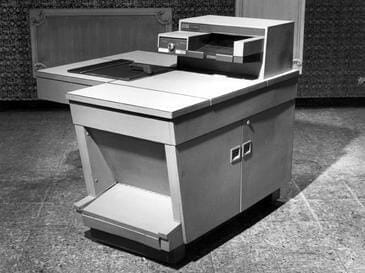
Articles
Editor’s Picks
80 Years Ago Today Xerography Was Invented
By Cait Etherington
October 22, 2018
 Eighty years ago today, in a home laboratory in Astoria, Queens, Chester Carlson invented a process that would come to be known as xerography. The process would provide the groundwork for the invention of copy machines. Copy machines still exist today, but they no longer rely on xerography and are generally considered an aging technology with limited functionality. This wasn’t the case in the mid- to late-twentieth century. For at least fifty years, work, education, and even politics were transformed by xerography.
Eighty years ago today, in a home laboratory in Astoria, Queens, Chester Carlson invented a process that would come to be known as xerography. The process would provide the groundwork for the invention of copy machines. Copy machines still exist today, but they no longer rely on xerography and are generally considered an aging technology with limited functionality. This wasn’t the case in the mid- to late-twentieth century. For at least fifty years, work, education, and even politics were transformed by xerography.
The Invention of the Copy Machine
Prior to the invention of the copy machine, creating a copy of any document was an onerous and messy process. In addition, existing methods, such as those carried out on mimeograph machines, required a master copy. This meant that you could only copy something if you had access to the master copy, and you could generally only make a limited number of copies before the master copy had to be replaced. With xerography, which literally means “dry writing,” copying underwent the greatest change since the invention of the printing press over five centuries earlier.
With Carlson’s invention, one could now copy a copy or copy a copy of a copy of a copy. One could also copy other things, including objects and parts of their body. Better yet, with the invention of the copy machine, one no longer needed to mess around with chemicals. Anyone, even someone with no special training, could reproduce any document in seconds.
Workplace Applications
Early on, copy machines were primarily promoted as a workplace technology. In fact, Xerox, which produced the earliest copy machines, actively attempted to promote copy machines as a viable way to replace one’s secretary. After all, why hire a female typist when you could purchase a machine that promised to be both more accurate and reliable? To fully appreciate just how sexist Xerox’s earliest campaigns were, one need only view one of Xerox’s vintage advertisements.
Although copy machines did eventually replace some office workers, far fewer jobs were lost than originally expected. It also wasn’t long before bored office workers, including female secretaries, started to get creative with these new office machines. From xeroxlore (a type of urban folklore that entailed the circulation of photocopied urban legends) to the photocopying of body parts, office workers found ways to embrace copy machines as a way to distract themselves from the monotony of their labor. In some cases, office workers also used copy machines to engage in more serious endeavors.
The Pentagon Papers would likely never have slipped out of a government office and handed over to the media had it not been for the photocopier. Over the coming decades, the photocopier would also continue to shape politics on other levels. If you were an activist in the 1980s or 1990s, there was nothing more coveted than having access to a workplace copy machine that could be used to produce posters, flyers, and other political documents right under your boss’s nose.
Copy Machines as an Educational Technology
Beyond the impact of copy machines on the workplace and politics, copy machines also represent an important chapter in ed tech history. In the 1960s, few schools, even colleges and universities, could afford copy machines, but as prices decreased in the late 1960s to early 1970s, copy machines soon came to play an integral role in higher education and eventually K-12 education.
Prior to xerography, copying an article or book was nearly impossible. As a result, people generally taught from textbooks and anthologies. With the copy machine’s arrival, educators could essentially create their own textbooks and anthologies. The ubiquitous “course kit” or “course reader” would transform both what and how people taught in the 1970s to 1990s. Likewise, as copy machines became increasingly ubiquitous, correspondence or distance education courses got a boost. In other words, both the curriculum and mode of delivery shifted as a result of the copy machine’s arrival in schools.
To be fair, copy machines were never perfect. Plagued by paper jams and seemingly always running out of ink, paper or both, many people despised copy machines. A 2002 study by Hewlett-Packard found that one in ten employees even admitted to kicking or punching their copy machine at some point. Despite their limitations, however, there is no question that had it not been for xerography and copy machines, we would be living in a very different world today.









[…] other words, it would appear that scalable mental health interventions—potentially those delivered by a mobile app—might be able to have a huge effect. These come in […]